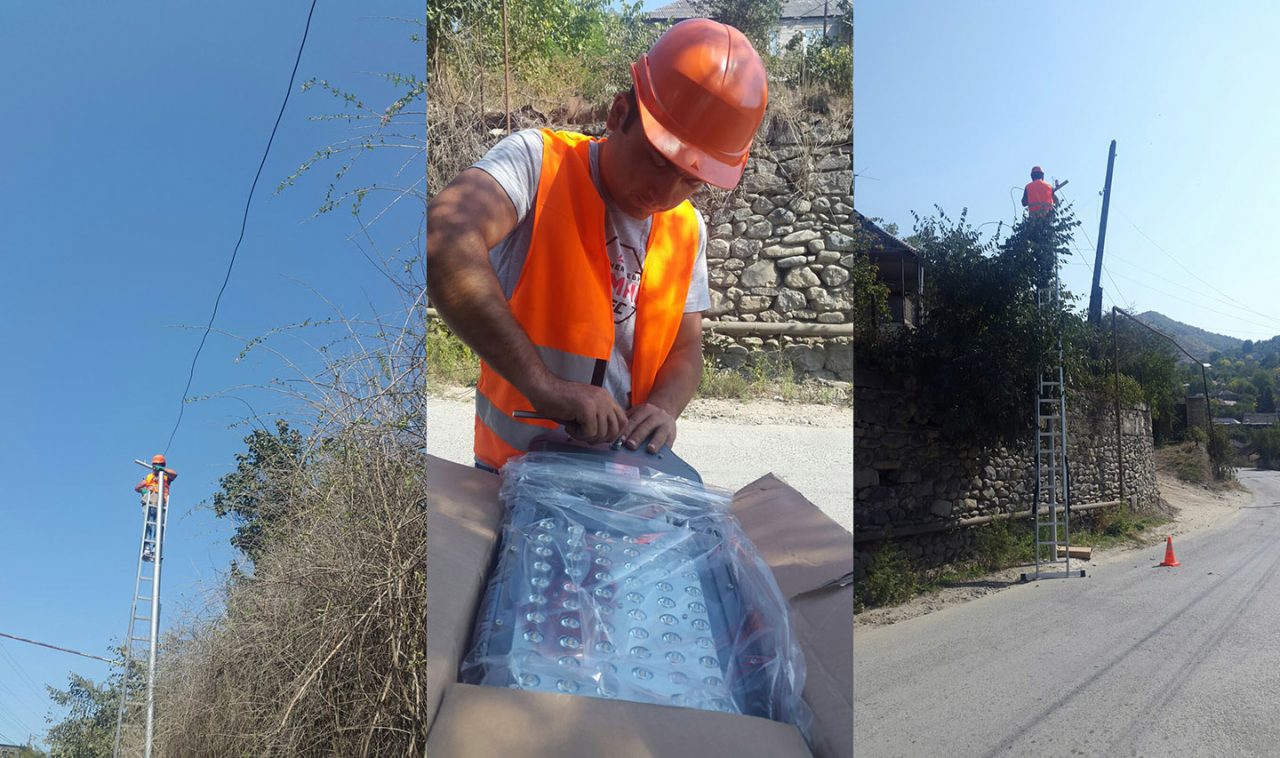
Vivacell-MTS: Installation of LED Lamps as a Means of Saving the Community Budget
There Are Active Works in Shnogh
The etymology of the name of Shnogh village of Lori marz, is related to reviving and constructing the land. And they tend to live in the village, likely. But there are almost the same problems that are typical of remote regions. One of them is the street lighting problem, which the community tried to solve but did not achieve the desired results. A certain part of the village has been illuminated, but some of the expensive lamps have gone out of order, causing new financial burdens. Shnogh has been assisted by partner organizations VivaCell-MTS and the Foundation for the Preservation of Wildlife and Cultural Assets (FPWC) to reduce the illumination costs and address lighting issues. The partners who acknowledge the importance of infrastructure development in the regions and the promotion of eco-friendly lifestyle, initiated the work of the installation of LED lamps in the eastern part of the Gugarats Range.
It was planned by the project to illuminate a 1.4 km long section, but during the research phase, the community expressed its willingness to make some investments, too. As a result, the length of the illuminated section has reached to 1.8 km instead of previously calculated shorter one. There is an awareness in the community that the effective management of the existing means should start with savings. The old and ineffective lamps made all this impossible. LED lamps are far superior in terms of savings, environmental impact and lighting quality.
“The final stage of the system introduction is underway. The works of installation of electric wires and mounting the lamps are carried out on the fixed poles. 47 energy-saving LED lamps will be installed in the village. Once commissioned, it will be possible to compare and asses the change,” said Martin Maralchyan, the project coordinator.
“Once the works are accomplished and the system is implimented, we can clearly calculate and understand the cost difference between exploiting the old and new LED lamps. Although we are already convinced that the cost will be lower, for sure. It would be desirable to replace the old lamps with LED ones in the secondary streets, too, in the future. Old lights are coming out of order, very quickly, there is always a need to replace them with new ones, which results to additional costs,” said David Ghumashyan, the head of the Shnogh enlarged community.
In the village of Shnogh, about 200 kilometers from the capital city, the commotion created during the implementation of the installation works is received there, with big enthusiasm. There is confidence that the remote village is not ignored, the innovative technologies are also available here, and ultimately, the savings will have a significant impact on the community budget.
———–
Eco villages network includes selected intentional or traditional communities throughout Armenia, that are consciously designed through locally owned, participatory processes to regenerate their social, cultural, economic and natural environments. The core idea behind the whole concept of the ecovillages is integrating the four dimensions of sustainability – ecological, economic, cultural and social – through integral, participatory design. The project is a new format of the long-term cooperation between the Foundation for the Preservation of Wildlife and Cultural Assets (FPWC), VivaCell-MTS and the Global Ecovillages Network (GEN) in the field of environmental protection and sustainable use of natural resources.
The Foundation for the Preservation of Wildlife and Cultural Assets (FPWC) was founded in Y2002. FPWC is a member organization of the International Union for the Conservation of Nature (IUCN) since Y2012. FPWC’s mission is to publicize the unique natural heritage of Armenia and the importance of biodiversity conservation, environmental issues and the importance of preserving nature. We aim to reduce human and wildlife conflict and its consequences to reduce the risks of endangered species of flora and fauna. Biodiversity conservation, environmental education, community development and public awareness are the main directions of our activities.
VivaCell-MTS (MTS Armenia CJSC) is Armenia’s leading telecommunications operator, having the widest network reach and spreading a wide range of Voice and Data services all across Armenia. Having the best of the Armenian people interest at heart since its launch on 1st July Y2005 and in a short period of time VivaCell-MTS has managed to build a nationwide network and a considerable customer base. VivaCell-MTS drives innovation and aims at always being at the forefront of any development serving the Armenian mobile communications market. The company follows the guidance provided by ISO 26000 (International Standard of Social Responsibility) and ISO/IEC 27001:2013 (Information Security Management System). For more information, visit www.mts.am
Mobile TeleSystems PJSC (“MTS”) is the leading telecommunications group in Russia and the CIS, offering mobile and fixed voice, broadband, pay TV as well as content and entertainment services in one of the world’s fastest growing regions. Including its subsidiaries, the Group services over 100 million mobile subscribers in Russia, Ukraine, Armenia and Belarus. Since July Y2000, MTS’ Level 3 ADRs have been listed on the New York Stock Exchange (ticker symbol MBT). Additional information about the MTS Group can be found at www.mtsgsm.com
